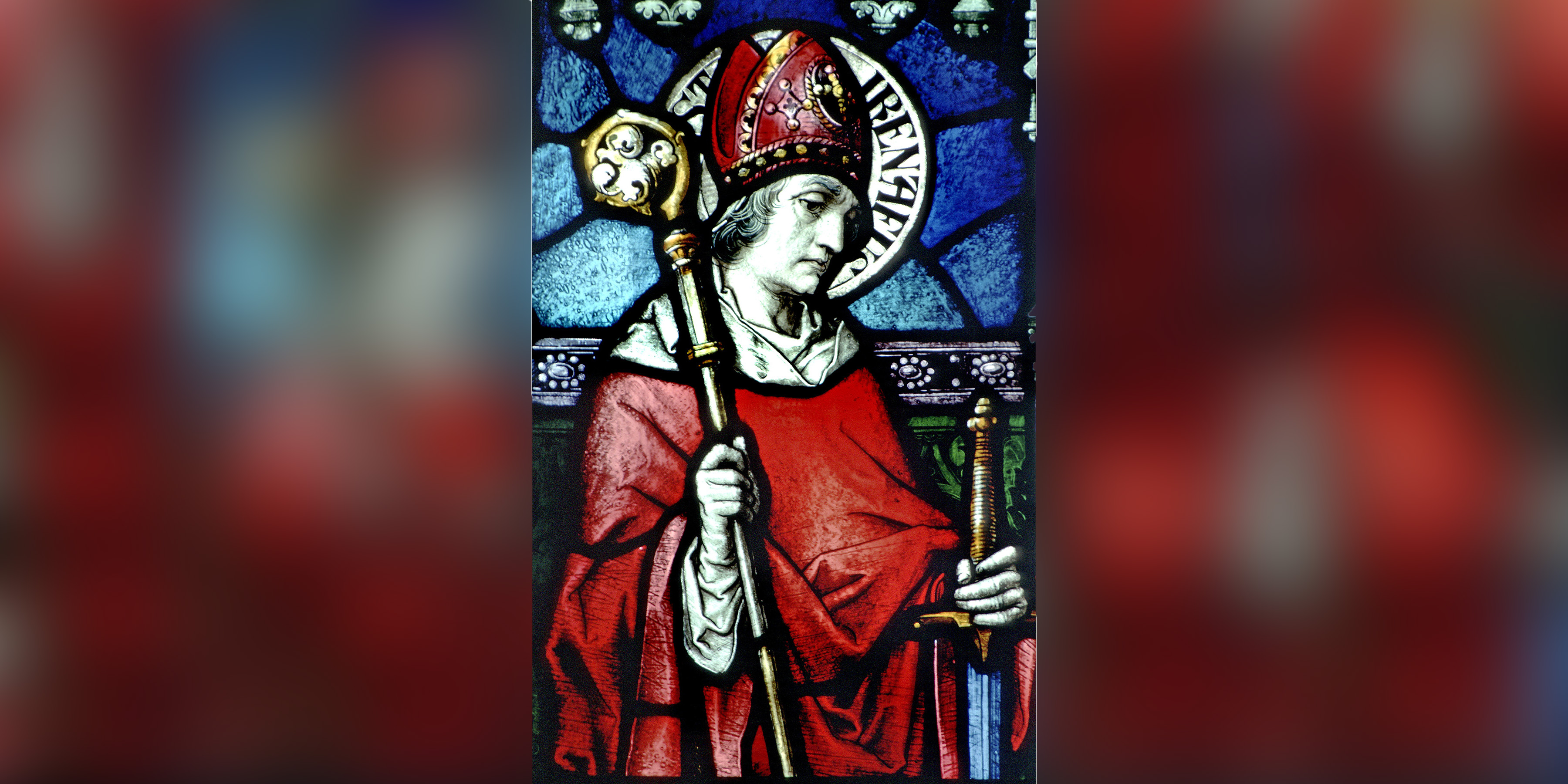During the 2nd session of their autumnal conference in Baltimore in 2019, the bishops of the United States considered an appeal from Cardinal Philippe Xavier Barbarin, archbishop of Lyon, France. The cardinal was seeking support for his request that the Holy Father bestow the title “Doctor of the Church” on the cardinal’s ancient predecessor, St. Irenaeus (c.125-202), second bishop of Lyon.
Cardinal Daniel DiNardo, the now-former president of the U.S. bishops conference, expressed astonishment that the saint was not already so designated; the bishops voted their support.
If the pope follows through, it will mark a major change. No martyr is on the list of doctors since, formerly, the Office and Mass for Doctors was similar to Masses composed for Confessors. Hence, as Pope Benedict XIV pointed out some years back, St. Ignatius of Antioch, St. Irenaeus of Lyon and St. Cyprian of Carthage — all martyrs, yet all responsible for important writings — are not called Doctors of the Church.
The honorific, doctor (the word reflecting its original Latin meaning, “teacher”), is awarded saints whose studies and writings have significantly clarified theological and doctrinal expressions, or aided devotional aspects of the Catholic faith. At present, only 36 saints have been named doctors of the Church.
Who is St. Irenaeus?
St. Irenaeus made himself a key personage within the second century of the Christian era. Born into a Christian family, his parents placed their young son under the inspired care of St. Polycarp, bishop of Smyrna in Asia Minor.
Through the good bishop’s efforts, Irenaeus learned the teaching of the apostles, several of whom Polycarp met, especially coming under the influence of St. John the Evangelist, who became Polycarp's mentor. For his part, the boy Irenaeus took his studies seriously and formed a great affection for his tutor.
Such was his veneration for Polycarp’s sanctity and wisdom, Irenaeus carefully observed the bishop’s words and gestures when he was preaching, the better to copy his example and learn his spirit. So well did he learn them that the impressions remained vivid even into his old age.
In Smyrna, Irenaeus acquainted himself with the conceits of pagan philosophers, with Gnosticism and Docetism. These two heresies proposed that Jesus was not truly human, that his body was only an illusion, reasoning that human flesh is too filthy to touch the pure spirit of God.
Irenaeus began writing, exposing the errors of these mistaken notions. He thus became known to the great defenders of Catholicism, Tertullian and Theodoret. St. Epiphanius, who wrote The Medicine Chest, revealing details of more than 80 heresies, speaks of Irenaeus as a luminous torch of truth in the darkness of the age.
Irenaeus spent a number of years combating Gnostic errors before Bishop Polycarp sent him to aid St. Pothinus, bishop of Lyon in Gaul, where the faith was taking root. Many heretics of Asia Minor were migrating there, creating a need for catechists fully imbued with knowledge and holiness.
Sailing up the Rhone, Irenaeus arrived with about 40 companions to the great joy of the elderly Bishop Pothinus, who confided to them his great need of their talents. It became clear, Irenaeus later remarked, that the neophytes in Lyon had difficulty distinguishing truth from Gnostic deviations.
Pothinus ordained Irenaeus just as one of the intermittent persecution flared up. The new priest repeatedly faced death, acting as his bishop’s good right arm. The civil authorities caught up with Pothinus, who glorified God with a martyr's death in 177.
With the death of the bishop, the persecutors imagined that they had stifled Christianity in Lyon; the persecution came to an end. The enemies of the faith acted without taking Irenaeus into account, who was soon consecrated successor to Pothinus, the second bishop of Lyon.
With the vicinity again at peace, heretics returned to again spread their lies about Jesus, his Church and salvation. This situation called forth Irenaeus’ most famous work, Adversus Haereses (“Against the Heresies”), an explanation of the faith coupled with a powerful denunciation of the heretics’ perversion of the Gospel.
Bishop Irenaeus continued to preach and imitate what he had heard and seen done by his beloved master, St. Polycarp, himself the disciple and imitator of St. John the Apostle. Steeped in Polycarp’s memories of St. John, Irenaeus kept lists of bishops in Rome and other cities going back to the apostles, to which he often referred, firmly establishing the truth of apostolic succession in the Church.
Irenaeus asserted that four Gospels — Matthew, Mark, Luke, and John — were canonical Scripture. It is on his authority that history attests the Gospel of John was written by the Apostle, and that the Gospel of Luke was written by the physician, the companion of Paul.
With his erudite, apostolic preaching, it took a short time for Bishop Irenaeus to bring most of the inhabitants of the countryside to know and love Jesus. It was seen that the strong faith, fidelity, knowledge and temperance of the new Christians of Lyon confounded heretical adversaries.
Bishop Irenaeus tells about another concern in the Church going back to about 120. Pope Sixtus learned that the bishops of Asia Minor kept the anniversary of the Crucifixion and Resurrection together on Passover, the 14th day of the month of Nisan, according to the Jewish lunar calendar. Sixtus asked them to follow the Roman custom of celebrating the Resurrection on the Sunday following Passover. They refused, and Sixtus did not pursue the issue, known as the Quartodeciman Controversy, which continued to simmer.
Around 150, Irenaeus writes, St. Polycarp traveled to Rome to discuss the matter with Pope Anicetus. He explained that the custom of celebrating the Resurrection on whatever day the Passover fell on was a tradition going back to the apostles SS. John and Phillip. Anicetus countered with the Roman tradition of celebrating the feast on Sunday as going back to SS. Peter and Paul. Without his agreement, Pope Anicetus still invited Bishop Polycarp to celebrate Mass with him, and they parted amicably.
The controversy remained unresolved when Victor I was elected pope in 189. The following year, he demanded the bishops of Asia Minor accept the Roman custom of celebrating the Resurrection on Sunday or face excommunication. Synods of local bishops were called in Judea, in Pontus, in Corinth, and in Gaul, the last presided over by Bishop Irenaeus. All of them found in favor of the Roman custom, but the general sentiment was expressed by Irenaeus in a letter to Pope Victor, informing him of Polycarp’s visit to Anicetus and advised that he forego excommunicating bishops for following a divergent yet still apostolic tradition. The dispute petered out by the mid-200s and was permanently resolved at the Council of Nicaea (325).
Persecution erupted during celebrations of the 10th year of the reign of Emperor Septimus Severus. Imperial decrees allowed the pagans the opportunity to take vengeance on the Christians who refused to participate in the debaucheries which accompanied the celebrations.
Assassins armed with daggers, stones and clubs roamed the city murdering any Christians they came upon, including the city’s bishop. St. Irenaeus is commemorated at Mass on June 28 by the Latin church; Aug. 23 in the Eastern churches.
Sean M. Wright is an Emmy-nominated television writer and novelist. He is a Master Catechist for the Archdiocese of Los Angeles and a member of the RCIA team at his parish, Our Lady of Perpetual Help in Santa Clarita. He replies to comments sent him at [email protected].










